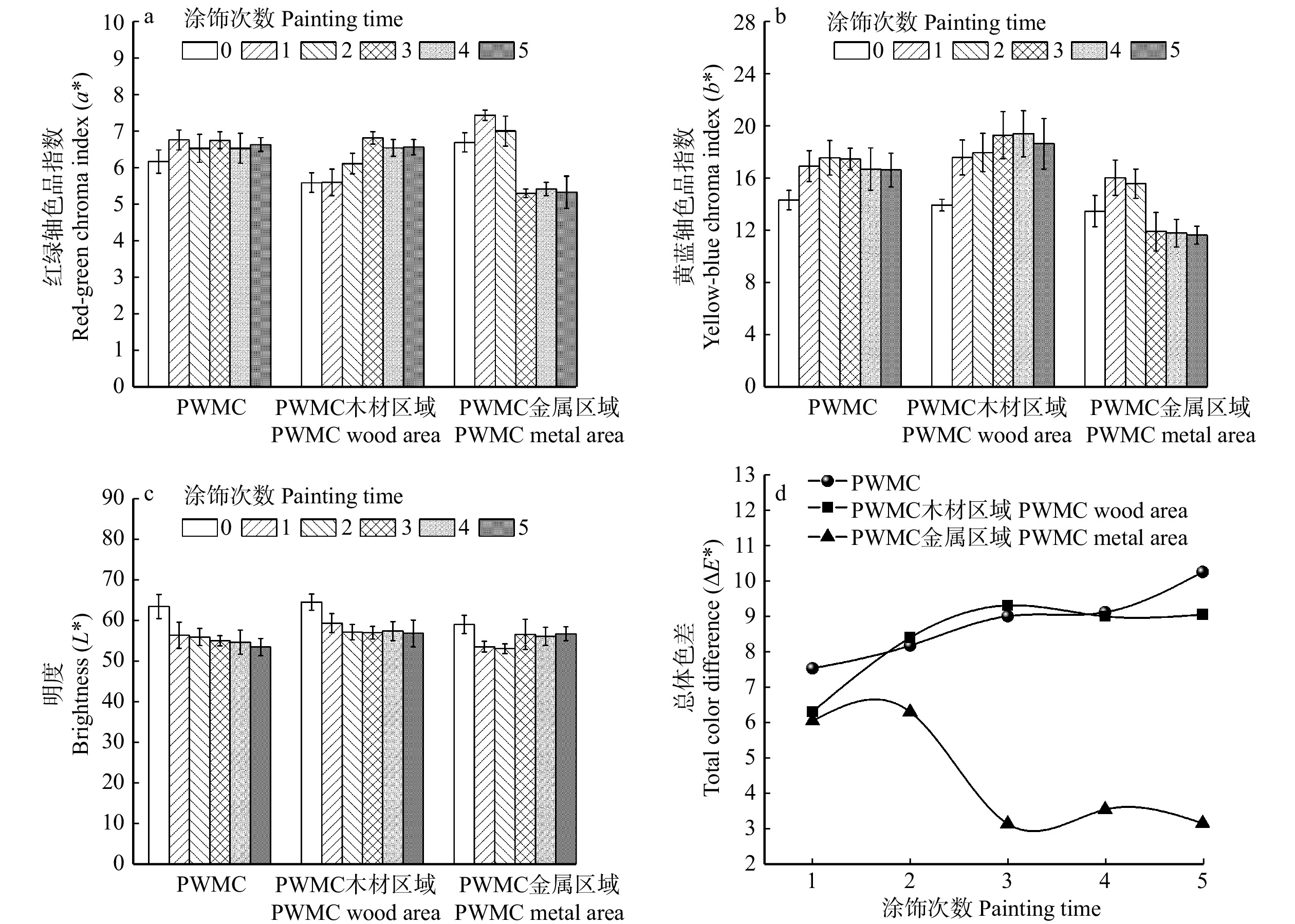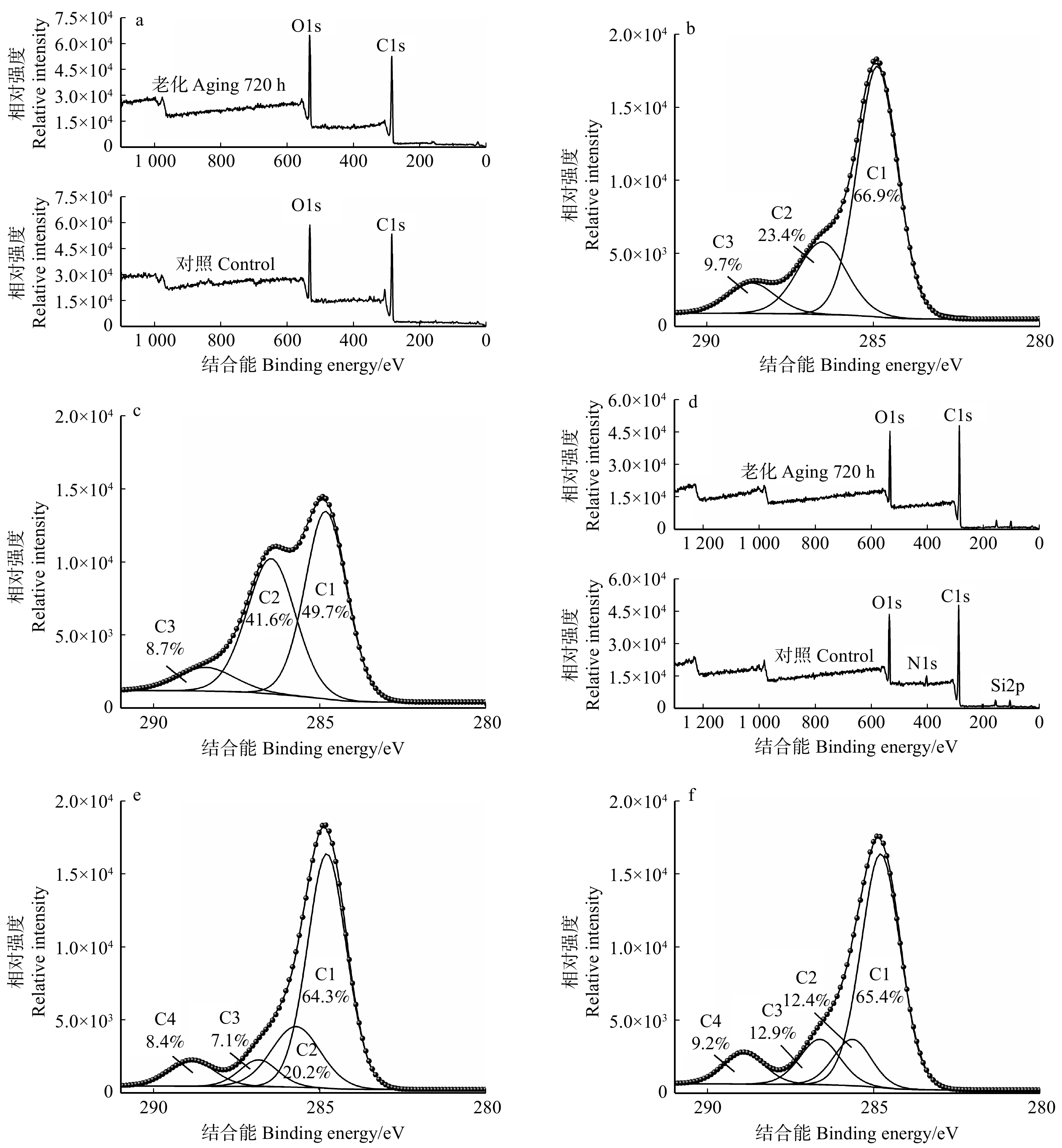Painting properties and lightfastness of microwave puffed wood-based metal composites
-
摘要:目的
微波膨化木基金属复合材料(PWMC)是一种密度适中、高导热、富有装饰性的新型金属木材料。为其未来在室内装饰、家居木制品等领域的高附加值应用提供技术支撑,开展了涂饰性能与耐光老化性的研究。
方法使用水性聚氨酯清漆涂饰PWMC,研究涂饰工艺对表面色度学参数和光泽度的影响,探讨砂纸目数与表面粗糙度间的关系。在紫外光老化条件下,研究光老化处理前后PWMC的色度学参数和光泽度变化,分析木材区域及表面聚氨酯涂层的光降解机理。
结果透明涂饰对PWMC发挥着保护与装饰的双重作用。三底两面透明涂饰处理后PWMC整体、木材和金属区域的总色差值分别为10.26、9.07和3.22,木材区域颜色变幅大于金属区域。涂饰后金属与木材两区域间的光泽度差异值由17.7降至2.3,表明涂饰处理能够有效降低光泽度差异。砂纸目数为240目时,PWMC各区域具有相近的粗糙度参数,差异值较小,表面平整且均一,此时漆膜附着力最佳(0级)。720 h光照下PWMC木材区域偏绿黄变化,木材与金属区域明度值增加;涂饰后木材与金属两区域的色度学参数变化幅度与失光率更低,证实了水性聚氨酯清漆对PWMC耐光性的提升作用。红外光谱与X射线光电子能谱显示PWMC木材区域与聚氨酯涂层中碳的氧化态升高,说明紫外光老化条件下发生了氧化降解。
结论本研究探明了微波膨化木基金属复合材料的涂饰性能与耐光性,为微波膨化木增值利用提供了理论和技术依据。
Abstract:ObjectivePuffed wood-based metal composite (PWMC) is decorative metallic wood material with a high thermal conductivity and moderate density. To provide technical reference for its future high value-added applications in the fields of interior decoration and household wooden products, the research on painting properties and lightfastness of PWMC had been carried out in this paper.
MethodWaterborne polyurethane paints were coated on PWMC surface. We studied the effect of painting number on the colorimetric parameters and gloss. The relationship between sandpaper grit and film adhesion was investigated by comprehensively analyzing the surface roughness parameters. Meanwhile, the surface color changes and gloss loss rate were characterized after 720 h artificially accelerated UV ageing treatment. The photodegradation mechanism was also analyzed by comparing the surface chemical structures.
ResultClear varnish finishes play a dual role of protection and decoration for PWMC. After the three-primers and two-topcoats painting treatment, the total color difference values of PWMC, wood area, and metal area were 10.26, 9.07 and 3.22, respectively. It indicated that the color variation of the wood area was larger than that of the metal area. The gloss value difference between wood and metal areas decreased from 17.7 to 2.3 after painting, representing that the painting treatment resulted in a more uniform surface gloss. The roughness parameters of PWMC wood and metal areas were similar when sandpaper grit was 240. It maintained a flat and homogeneous surface, thus PWMC had a best paint film adhesion (level 0). Under artificially accelerated UV ageing of 720 h, PWMC wood area changed to greenish-yellow, and the lightness of wood and metal areas increased. The colorimetric parameter changes and light loss rate of wood and metal areas were reduced after painting. It confirmed that the enhancement of waterborne polyurethane paints on the lightfastness of PWMC. Infrared spectroscopy and X-ray photoelectron spectroscopy showed an increase in the oxidation state of carbon atoms, indicating oxidative degradation happened in PWMC wood area and coating paints under light irradiation.
ConclusionThe painting properties and lightfastness are investigated, providing a theoretical and technical basis for the value-added utilization of PWMC.
-
在农林业生产中,植物常遭受重金属等各种土壤条件胁迫。铅(Pb)是重金属污染物中影响较严重的元素之一,又是植物非必需元素,其在组织中大量积累会引起植物体内细胞膜脂过氧化,最终影响生长和品质[1-2],因此修复Pb胁迫土壤具有重要意义。作为生态修复的重要内容之一,植物修复已成为近年来国际环境领域研究的热点[3]。在Pb胁迫土壤的植物修复中,特别是在植物生长初期,如何提高植物适应性和存活力尤其引人关注。
作为一种天然螯合剂,土壤中各种来源的有机酸显著影响重金属在土壤中的迁移转化行为及植物有效性,在控制Pb等重金属生物毒性方面发挥重要作用[4-5]。植物对重金属的解毒机制包括外部排斥和内部耐受两类,这两类机制中有机酸均起重要作用[6-7]。外部排斥机制即有机酸与金属离子形成稳定的金属配位体复合物,阻止金属离子进入植物体内或避免其在根部敏感位点累积;内部耐受机制即有机酸可与进入植物体内的金属离子螯合,使其转化为无毒或毒性较小的结合形态[7-8]。在重金属胁迫下,植物一般通过多种机制的联合以防止中毒,但植物种类不同解毒机制也不同[7]。有机酸还显著影响Pb胁迫下植物的多种生理生化特性、生长和生物量分配格局,最终提高Pb胁迫土壤上植物的生态适应性及土壤修复效率[4]。有机酸对上述指标的影响,不仅与植物种类有关,还与有机酸种类和浓度、Pb胁迫程度和处理时间等密切相关[11]。目前,有机酸提高植物适应性的作用已在一些植物上证实,如欧洲油菜(Brassica napus)、马蔺(Iris lactea var. chinensis)等,有机酸种类涉及草酸、柠檬酸和水杨酸等,测定指标涉及电导率、可溶性蛋白含量、Pb吸收和生物量积累等[9-11]。值得指出的是,除上述常规指标外,叶绿素荧光参数、根系形态特性和养分元素吸收也是鉴定植物抗逆性的重要指标,是植物适应土壤环境的基础[12];且F0、Fv/Fm和Fv/F0等荧光指标、比根长等根系形态特征及Fe等养分元素吸收状况对Pb胁迫都非常敏感[13-14]。但目前,外源有机酸影响植物对土壤Pb胁迫的适应性研究仍集中在农业领域,在林业领域相对较少,特别是如何影响Pb胁迫下林木的叶绿素荧光参数、根系形态特性和营养元素吸收运输还鲜见报道。
我国东北林区有一定面积的矿山土急需复垦,如黑龙江省伊春西林铅锌矿等。这些立地条件下,Pb胁迫普遍存在。长白落叶松(Larix olgensis)是东北山区的重要乡土树种,因成活率高和对环境要求不甚严格,就成为Pb胁迫矿山土植被恢复和林业复垦的先锋树种。但在较严重的Pb胁迫下,其成活和生长仍受较大限制,特别是初期“造林不成活”现象普遍存在。通过前人研究可以假设,外源有机酸亦能在苗期提高长白落叶松对Pb胁迫的适应性和抗性。但目前,有机酸如何影响Pb胁迫下长白落叶松幼苗的生态适应性还未见报道。草酸和柠檬酸是我国东北林区森林凋落物淋洗液中存在的2种优势有机酸,数量均较为可观[15]。本文模拟此区长白落叶松凋落物淋洗液中草酸和柠檬酸浓度范围[15],通过外源添加不同浓度草酸或柠檬酸溶液,系统研究了不同处理时间下,有机酸对长白落叶松幼苗多种生理生化特性、Pb及养分元素吸收及生长的影响,特别是首次揭示了有机酸如何影响Pb胁迫下苗木的叶绿素荧光参数、根系形态特征及养分元素吸收状况。研究旨在探讨有机酸对Pb胁迫下苗木生态适应性的调控意义及机制,从而为有机酸应用于Pb矿区废弃地的植被恢复提供生理生态学理论依据,也能为Pb胁迫土壤的有效利用开辟新思路。
1. 材料与方法
1.1 苗木培育与处理
实验在东北林业大学帽儿山实验林场温室内进行。长白落叶松种子选种、消毒、雪藏催芽后,2016年4月末播种于塑料育苗盆(底径16.2 cm、上口径18.4 cm、高20.0 cm),覆土料为质地均一、无杂质的A1层暗棕壤(本区地带性土壤,基本性质见表 1)。土壤采自林场内长白落叶松人工林下,去除根系、土壤动物等,自然风干1 d,装盆,每盆5.5 kg。每盆育苗60株,盆上沿土壤空出2~3 cm以浇水、有机酸和Pb处理。2016年5月末间苗,每盆剩30株(由于当地气候条件限制,苗木生长缓慢,出苗1个月时平均苗高仅4.3 cm,平均地径1.05 cm,这样的密度有利于形成良好的种群优势,而不会产生生长空间的竞争)。
表 1 供试A1层暗棕壤的基本性质Table 1. Selected properties of A1 horizon of dark brown forest soil used in the experiment土壤层次
Soil layerpH值
pH value (H2O)阳离子交换量
Cation exchange capacity/(cmol·kg-1)有机质
Organic matter/ (g·kg-1)全氮
Total N/ (g·kg-1)全磷
Total P/ (g·kg-1)速效磷
Available P/ (mg·kg-1)土壤质地
Soil texture黏粒Clay (<2 μm)/ (g·kg-1) 草酸含量
Oxalic acid concentration/(μg·kg-1)柠檬酸含量
Citric acid concentration/(μg·kg-1)A1 5.32 40.2 107.9 6.39 2.08 45.8 壤质
Loamy texture135 310.98 139.83 注:30 mmol/L NH4F+25 mmol/L HCl浸提法;A1为暗棕壤层。下同。Notes: means extracted with 30 mmol/L NH4F+25 mmol/L HCl; A1 means horizon of dark brown forest soil. The same below. 缓苗1月后,将Pb(NO3)2溶液均匀地添加到土壤中以进行Pb胁迫处理,使土壤内Pb2+含量达100 mg/kg(依前期调查的黑龙江省伊春西林铅锌矿区土壤Pb含量设定)。Pb处理10 d后,采取灌根方式进行外源有机酸添加处理[草酸(OA)或柠檬酸(CA)],使土壤内有机酸浓度分别达0、0.04、0.2、1.0和2.0 mmol/kg。另外,在长白落叶松苗期,由于其根系生长慢且发育不完全[16],还采用类似叶面施肥的方式进行了有机酸喷施[17]。具体讲:将有机酸溶液(浓度分别为0、0.2、1.0、5.0和10.0 mmol/L)均匀地喷施在苗木叶片的上、下表面,以叶面均匀湿润为止。实验处理见表 2。有机酸以有机盐形式添加(pH 5.16,仿当地土壤溶液平均pH值),每天1次,共7 d,均在早晨08:00进行。土壤无Pb胁迫、等量蒸馏水处理为对照(CK)。由于当地气候寒冷,温室育苗最早也得在4月末进行,8月下旬叶片已开始变黄脱落,不能再进行相关指标的准确测定。综合考虑出苗、缓苗、Pb胁迫和有机酸处理等时间,分别在有机酸处理后第10、20、30天采样分析。每处理栽10盆苗,每个处理时间10个重复,3个时间共300盆。
表 2 实验设计(10、20、30 d均进行如下处理)Table 2. Experimental layout (each of the treatments below was sampled after 10, 20, or 30 days)处理Treatment 土壤处理Soil treatment 有机酸类型Kind of organic acid 有机酸浓度Concentration of organic acid/(mmol·L-1) CK A1、无Pb
A1, no Pb― 0 T1 A1+Pb ― 0 T2 A1+Pb OA 0.2 T3 A1+Pb OA 1.0 T4 A1+Pb OA 5.0 T5 A1+Pb OA 10.0 T6 A1+Pb CA 0.2 T7 A1+Pb CA 1.0 T8 A1+Pb CA 5.0 T9 A1+Pb CA 10.0 1.2 样品采集与测定
1.2.1 生理生化指标和元素含量
在各处理10盆苗木中,随机采集中部叶片(约2.0 g),立即、分别用上海雷磁DDS-6700电导仪和考马斯亮蓝G-250染色法测定相对电导率和可溶性蛋白含量。再随机采集苗木中部叶片,把采过叶片的幼苗小心地从土中取出(避免根系损伤),采集 < 2 mm细根。叶片和细根用蒸馏水洗净擦干,105 ℃下杀青15 min,70 ℃下烘至恒质量,粉碎,过2 mm尼龙筛,用微波消解ICP-MS法测定叶片和细根Pb、Mg和Fe含量。每处理重复3次。
每处理选3株幼苗暗处理20 min后,选取完整叶片用LI-6400 XT便携式光合仪(Licor,US)测定叶绿素荧光指标。通过测得的F0(初始荧光)和Fm(最大荧光),计算得到Fv/Fm和Fv/F0,其中Fv=Fm-F0。每处理重复3次。
1.2.2 根系形态特征
在各处理10盆苗木中,每处理随机选3株幼苗,小心地将根系取出,用去离子水洗净,用滤纸小心吸干,用枝剪将根、茎和叶分开,再用根系分析仪(Win-RHI Z0-2004a,Canada)测定根系形态,得到表面积、长度、体积和平均直径,并计算得到比根长(长度/干质量)。
1.2.3 生长
在各处理10盆苗木中,每处理选15株幼苗,小心地从盆中取出,将茎、叶和根分开,用去离子水洗净吸干,105 ℃下杀青15 min,60 ℃下烘至恒质量,得到各部分干质量及平均值。
1.3 数据处理
用SPSS 18.0对数据进行统计分析,采用Duncan新复极差法对所有指标数据进行差异显著性检验(P < 0.05)。
2. 结果与分析
2.1 苗木细胞膜透性变化
与对照(CK)比,Pb胁迫(T1)增加苗木叶片相对电导率,说明叶片细胞膜受损,且时间越长损伤越重。与无有机酸处理(T1)相比,草酸和柠檬酸显著降低Pb胁迫下苗木的相对电导率,2种有机酸均在10.0 mmol/L效果最好,柠檬酸强于草酸,不同时间效果为30 d>10 d>20 d(图 1)。
2.2 可溶性蛋白含量变化
与CK相比,苗木叶片可溶性蛋白含量在Pb胁迫后(T1)降低(时间越长降幅越大),但有机酸处理后显著提高,所有处理均达显著水平,5.0或10.0 mmol/L效果最好,2种有机酸增幅均为10 d>30 d>20 d,柠檬酸作用强于草酸(图 2)。
2.3 叶片叶绿素荧光参数变化
Pb胁迫显著影响叶片叶绿素荧光指标,F0升高,Fm、Fv、Fv/Fm和Fv/F0均降低。有机酸使上述指标均向相反方向变化,变化幅度与其浓度大体呈正相关,一般10.0 mmol/L变幅最大。不同时间内各指标变幅不同:F0为30 d>20 d>10 d,Fm为30 d>10 d>20 d,Fv为30 d>20 d>10 d,Fv/Fm和Fv/F0为30 d>20 d>10 d。除少数0.2 mmol/L处理外,柠檬酸影响均强于草酸(图 3)。
2.4 根系形态特征变化
Pb胁迫显著影响苗木根系形态特征,表面积、长度、体积和比根长降低,时间越长降幅越大,但平均直径增加。有机酸使上述指标向相反方向变化,大都以10.0 mmol/L影响最显著,柠檬酸强于草酸。表面积、长度、体积、比根长和平均直径时间序列分别为30 d>20 d>10 d,30 d>20 d>10 d,30 d>20 d>10 d,10 d>20 d>30 d和10 d>30 d>20 d(图 4)。
2.5 苗木体内Pb和营养元素含量变化
Pb胁迫显著增加细根和叶片Pb含量,且在根部强烈积累。有机酸使细根和叶片Pb含量先降后增,大多在10.0 mmol/L时仍低于有机酸0组(T1)。对于根系Pb积累,草酸影响大多强于柠檬酸,叶片则相反。不同有机酸浓度和处理时间内无明显规律。Pb胁迫增加细根和叶片Fe含量及细根Mg含量,但降低叶片Mg含量。有机酸降低细根和叶片Mg含量,但增加Fe含量,大多在10.0 mmol/L变幅最大。不同时间内细根Mg含量降幅为30 d>20 d>10 d,Fe含量增幅为10 d>20 d>30 d;叶片Mg含量降幅为30 d>20 d>10 d,Fe含量增幅为30 d>10 d>20 d。除极少数处理外,柠檬酸效果强于草酸(图 5)。
2.6 生长变化
与CK相比,Pb胁迫显著降低苗木的根、茎和叶干质量,但有机酸处理后各部分干重量大多显著增加,一般10.0或5.0 mmol/L增加效果最显著,不同时间的增加效果为20 d>30 d>10 d,柠檬酸效果强于同浓度草酸(图 6)。
3. 讨论
3.1 有机酸对Pb胁迫下细胞膜系统的保护作用
Pb胁迫显著增加长白落叶松叶片相对电导率和质膜透性(图 1),可能Pb与细胞膜上的磷脂作用形成正磷酸盐、焦磷酸盐,从而改变膜结构;或者Pb被细胞壁上果胶酸吸附,改变了细胞壁弹性和塑性,损害了壁的生理功能[18]。本结果与玉米(Zea mays)[18]、海榄雌(Avicennia marina)[19]等研究一致。Pb胁迫下,草酸和柠檬酸显著降低长白落叶松相对电导率(图 1),说明有机酸减缓了电解质渗出和细胞膜损伤,能通过提高质膜系统稳定性诱导苗木适应性,此结果与柠檬酸和草酸对马蔺[9]、柠檬酸对灯心草(Juncus effuses)[20]等研究一致。
3.2 有机酸与Pb胁迫下的渗透调节物质
作为渗透调节物质,可溶性蛋白含量能反映植物总体代谢状况及抗逆性[21]。Pb降低长白落叶松叶片可溶性蛋白含量(图 2),说明此时苗木体内代谢改变及蛋白质合成受阻,且时间延长影响增大。Pb胁迫下蜡熟期玉米、镉(Cd)污染下苎麻(Plagiomnium acutum)等研究也如此,且随重金属浓度升高而下降[18, 22]。但也有人认为,Pb等胁迫下,植物除合成蛋白质以络合进入体内的重金属离子、降低其危害外,可溶性蛋白含量上升还能增加细胞渗透浓度和功能蛋白数量,有助于维持细胞正常代谢[23]。
外源有机酸提高长白落叶松可溶性蛋白含量(图 2),说明此时苗木的生理生化反应与代谢活动都显著增强,进而能从渗透调节角度提高苗木对Pb胁迫的适应性。同样,1.5和4 mmol/L柠檬酸也使苎麻叶片和根系可溶性蛋白含量分别增加2.9和6.4 mg/g,但高浓度草酸(9 mmol/L)却使叶片含量降低3.1 mg/g[22]。
3.3 叶绿素荧光对Pb胁迫和有机酸的响应
Pb诱导长白落叶松叶片F0显著上升(图 3),这与Pb、Cd胁迫下银芽柳(Salix leucopithecia)、云南樟(Cinnamomum glanduliferum)等研究一致[24-25],且增加越多损伤越重[26]。但Pb降低黑麦草(Lolium perenne)F0,随其浓度而下降,可能因为Pb降低叶绿素含量,使捕获和传递给PSII反应中心的光能减少、电子传递受阻[27]。Pb还降低长白落叶松Fv/Fm和Fv/F0(图 3),说明Pb离子抑制光合作用原初反应,使其开放程度和捕获激发能效率下降,这可能与其抑制叶绿素合成有关,或由于Pb竞争性抑制放氧复合体中23kd蛋白上Ca2+和Cl-结合位点,从而阻止电子从PSII向PSI传递[28]。本结果与云南樟[25]、尖叶走灯藓(Plagiomnium cuspidatum)[29]、玉米[30]、黑麦草[31]等研究一致。但也有不同报道,如100 μmol/L和0.25 mmol/L Pb分别对柳条莫丝(Fontinalis antipyretica)和玉米Fv/Fm影响均不明显[28, 32]。Pb引起Fv/Fm和Fv/F0变化一般与其浓度显著正相关[28, 33],且有明显的时间效应,时间越长长白落叶松Fv/Fm和Fv/F0降幅越大(图 3),但高浓度Pb使湿地匍灯藓(Plagiomnium acutum)Fv/F0第1天即明显降低,低浓度则先增后降[34]。
有机酸如何影响植物(特别是重金属胁迫下)叶绿素荧光参数目前还鲜见报道。Pb等重金属可能通过影响水裂解端电子流而降低PSII原初光能捕获能力和电子传输能力[35],抑制点主要在光系统II氧化面[36]。Pb还刺激PSII核心蛋白磷酸化,影响PSII复合物稳定性和D1蛋白降解速率[30]。Pb和柠檬酸存在下,田青(Sesbania drummondii)幼苗Fv/Fm和Fv/F0不变,光合效率正常[37];但Pb和草酸或柠檬酸处理下,长白落叶松F0降低,Fv/Fm和Fv/F0升高(图 3),说明有机酸明显抑制Pb引起的PSII光合反应中心损伤,有效缓解反应中心吸收的光能用于电子传递量子产额的降幅,减轻光合电子传递和光抑制,提高了光合活性。上述差异可能与植物类型、Pb处理方式和水平及有机酸浓度等不同有关。
3.4 Pb胁迫、有机酸与植物根系形态、元素吸收和生长
Pb降低长白落叶松根系表面积、长度、体积和比根长(图 4),说明Pb已超过苗木耐受范围,并抑制根系纵向生长,这与高羊茅(Festuca elata)、多年生黑麦草[38]、马蔺[10]及麻疯树(Jatropha curcas)[39]等研究一致。Pb还增加苗木根系平均直径(图 4),即使根系变粗膨大,可能因为Pb影响了根细胞增殖和分化,特别是根尖细胞的分裂分化。Pb对根系毒害明显强于芽等其他器官[40-41],可能因为根最先感受毒害,根细胞壁上还有能大量固定Pb离子的交换位点,根尖吸收Pb后诱发过量的自由基产生,从而伤害根系代谢中的琥珀酸脱氢酶等,降低根系活力,并抑制其向地上部转移[42]。
有机酸明显促进Pb胁迫下长白落叶松生长(图 6),可能原因包括:1)有机酸益于叶绿素荧光、可溶性蛋白等生理特性(图 1~3),这不但能提高光合速率促进有机物积累,还有益于水和无机盐运输。2)有机酸促进根系生长(图 4),这能缓解Pb对根系活力和生理功能的限制,还增加苗木与土壤的接触面积及Fe等养分的吸收利用(图 5),减缓Pb胁迫导致的某些养分吸收利用受抑而引起的干物质积累减少。Pb也破坏菲白竹(Pleioblastus fortunei)体内矿质营养平衡,特别是打破Na+/K+平衡是Pb毒害主要原因[43]。本结果与柠檬酸、草酸等对马蔺影响一致[9]。对长白落叶松生理特性和养分吸收的影响柠檬酸均强于草酸,对生长影响也如此。
外源有机酸能缓解植物的重金属中毒症状,在植物对重金属的外部排斥(即避性机制)和内部耐受等机制中均发挥重要作用[7-8, 44]如柠檬酸和酒石酸分别可减轻Pb、Cd对萝卜(Raphanus sativus)的毒害[45],柠檬酸还促进Pb和Cd从其根系向地上部的转运[46]。本研究发现,较低浓度草酸和柠檬酸处理时,长白落叶松幼苗细根和叶片Pb含量降低,说明此时苗木对Pb胁迫的解毒机制主要体现在外部排斥机制。5.0~10.0 mmol/L较高浓度有机酸处理时,苗木体内Pb含量升高,则此时内部耐受机制发挥的作用更大,但也不排除2种机制同时起作用的可能性。
4. 结论
1) 长白落叶松幼苗对Pb胁迫响应明显,叶片细胞膜透性和F0提高,叶片可溶性蛋白含量、Fm、Fv、Fv/Fm和Fv/F0,根系表面积、长度、体积和比根长都降低,细根和叶片Pb含量显著增加,叶片Mg含量及根、茎和叶干质量降低,且时间越长影响越大。
2) 外源草酸和柠檬酸使上述生理生化和根系形态指标均向相反方向变化,显著增加苗木各部分干质量,因此外源有机酸对提高长白落叶松对Pb胁迫土壤的生态适应性有积极意义。
3) 较低浓度草酸和柠檬酸对苗木解毒Pb胁迫的机制主要体现在外部排斥机制,5.0~10.0 mmol/L较高浓度处理时则内部耐受机制作用更大,但也不排除2种机制同时起作用的可能性。
4) 外源有机酸对苗木生态适应性的影响,一般在20或30 d、5.0或10.0 mmol/L效果最好,且柠檬酸强于草酸。
-
-
[1] 王振宇, 林兰英, 傅峰, 等. 木材高强微波处理及其结构失效机制研究进展[J]. 林业工程学报, 2022, 7(4): 13−21. Wang Z Y, Lin L Y, Fu F, et al. Research progress on high-intensity microwave treatment and failure mechanism of wood[J]. Journal of Forestry Engineering, 2022, 7(4): 13−21.
[2] Zhang Y, Lin L Y, Fu F. High-permeability wood with microwave remodeling structure[J]. Forests, 2021, 12: 1432. doi: 10.3390/f12111432
[3] Chai Y, Liang S Q, Zhou Y D, et al. Low-melting-point alloy integration into puffed wood for improving mechanical and thermal properties of wood–metal functional composites[J]. Wood Science and Technology, 2020, 54: 637−649. doi: 10.1007/s00226-020-01174-5
[4] 柴媛, 陶鑫, 梁善庆, 等. 填缝型微波膨化木基金属复合材料制备及其性能表征[J]. 北京林业大学学报, 2021, 43(10): 118−125. Chai Y, Tao X, Liang S Q, et al. Preparation and property characterization of crack-filled type microwave puffed wood based metal composites[J]. Journal of Beijing Forestry University, 2021, 43(10): 118−125.
[5] 刘一星, 于海鹏. 透明涂饰对木材纹理等视觉特征的影响分析[J]. 林业科学, 2006, 42(12): 90−94. Liu Y X, Yu H P. Effect of clear lacquer on textural vision of wood surface[J]. Scientia Silvae Sinicae, 2006, 42(12): 90−94.
[6] 侯新毅, 姜笑梅, 殷亚方. 从色度学参数研究3种桉树木材的透明涂饰性能[J]. 林业科学, 2006, 42(8): 57−62. Hou X Y, Jiang X M, Yin Y F. Study on clear painting properties for three eucalyptus plantation woods from the chromatic parameters[J]. Scientia Silvae Sinicae, 2006, 42(8): 57−62.
[7] 皇权飞, 黄艳辉, 张唯, 等. 基于水曲柳基材的水性漆漆膜性能研究[J]. 北京林业大学学报, 2020, 42(7): 140−146. Huang Q F, Huang Y H, Zhang W, et al. Film properties of waterborne paint based on Fraxinus mandshurica substrate[J]. Journal of Beijing Forestry University, 2020, 42(7): 140−146.
[8] Tao X, Tian D X, Liang S Q, et al. Facile strategy for preparing puffed wood-based metal composites with low density and enhanced thermal conduction via high-intensity microwave puffing pretreatment[J]. Industrial Crops and Products, 2023, 194: 116388. doi: 10.1016/j.indcrop.2023.116388
[9] 孙丹, 李鸽. GB/T3505—2009《产品几何技术规范(GPS) 表面结构 轮廓法 术语、定义及表面结构参数》标准介绍[J]. 机械工业标准化与质量, 2010, 443(4): 17−24. Sun D, Li G. Standard introduction of GB/T3505−2009 geometrical product specification (GPS)-surface texture: profile method-terms, definitions, and surface texture parameters[J]. Machinery Industry Standardization & Quality, 2010, 443(4): 17−24.
[10] Han J J, Wei Z, Wang G. Investigation of influence factors on surface roughness of micro-scale features[J]. Precision Engineering, 2019, 56: 524−529. doi: 10.1016/j.precisioneng.2019.02.010
[11] 林兰英, 何盛, 傅峰, 等. 基于图像处理的微波处理材裂纹评价[J]. 林业科学, 2014, 50(4): 84−89. Lin L Y, He S, Fu F, et al. Evaluation of the cracks in microwave-treated lumbers based on image processing[J]. Scientia Silvae Sinicae, 2014, 50(4): 84−89.
[12] 刘梓灵, 涂登云, 周桥芳, 等. 压缩工艺和热处理对单侧表层压缩木涂饰性能的影响[J]. 木材科学与技术, 2022, 36(6): 75−81. Liu Z L, Tu D Y, Zhou Q F, et al. Effect of compression process and heat treatment on coating performance of unilaterally surface-densified wood[J]. Chinese Journal of Wood Science and Technology, 2022, 36(6): 75−81.
[13] Sulaiman O, Hashim R, Subari K, et al. Effect of sanding on surface roughness of rubberwood[J]. Journal of Materials Processing Technology, 2009, 209(8): 3949−3955. doi: 10.1016/j.jmatprotec.2008.09.009
[14] 张梦莹, 吕建雄, 李萍, 等. 硅酸盐改性杨木表面粗糙度对漆膜附着性能的影响[J]. 林业工程学报, 2022, 7(6): 196−201. Zhang M Y, Lü J X, Li P, et al. Influences of surface roughness on the paint film adhesion properties of silicate-modified poplar[J]. Journal of Forestry Engineering, 2022, 7(6): 196−201.
[15] Tayeh B A, Bakar B A, Johari M M, et al. The relationship between substrate roughness parameters and bond strength of ultra high-performance fiber concrete[J]. Journal of Adhesion Science and Technology, 2013, 27(16): 1790−1810. doi: 10.1080/01694243.2012.761543
[16] 刘晓玲, 陈松武, 冯沁雄, 等. 桉木透明涂饰漆膜耐光性的研究[J]. 西北林学院学报, 2020, 35(2): 223−228. Liu X L, Chen S W, Feng Q X, et al. Light fastness of clear painted varnish film on encalyptus wood[J]. Journal of Northwest Forestry University, 2020, 35(2): 223−228.
[17] Müller U, Rätzsch M, Schwanninger M, et al. Yellowing and IR-changes of spruce wood as result of UV-irradiation[J]. Journal of Photochemistry and Photobiology B: Biology, 2003, 69(2): 97−105.
[18] 王小青, 任海青, 赵荣军, 等. 毛竹材表面光化降解的FTIR和XPS分析[J]. 光谱学与光谱分析, 2009, 29(7): 1864−1867. Wang X Q, Ren H Q, Zhao R J, et al. FTIR and XPS spectroscopic studies of photodegradation of moso bamboo ( Phyllostachys pubescens Mazel)[J]. Spectroscopy and Spectral Analysis, 2009, 29(7): 1864−1867.
[19] Wang X Q, Ren H Q. Comparative study of the photo-discoloration of moso bamboo ( Phyllostachys pubescens Mazel) and two wood species[J]. Applied Surface Science, 2008, 254(21): 7029−7034. doi: 10.1016/j.apsusc.2008.05.121
[20] Liu J, Li Z, Zhang L W, et al. Degradation behavior and mechanism of polyurethane coating for aerospace application under atmospheric conditions in South China Sea[J]. Progress in Organic Coatings, 2019, 136: 105310. doi: 10.1016/j.porgcoat.2019.105310
-
期刊类型引用(1)
1. 徐婷婷,余秋平,漆培艺,刘可慧,李艺,蒋永荣,于方明. 不同淋洗剂对矿区土壤重金属解吸的影响. 广西师范大学学报(自然科学版). 2019(02): 188-193 .  百度学术
百度学术
其他类型引用(1)



 下载:
下载:













